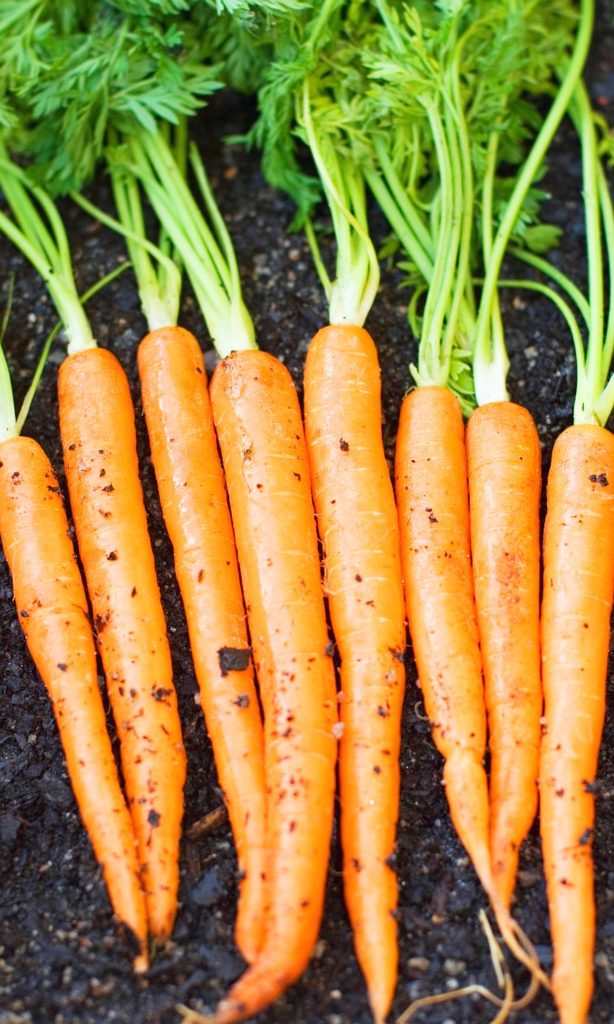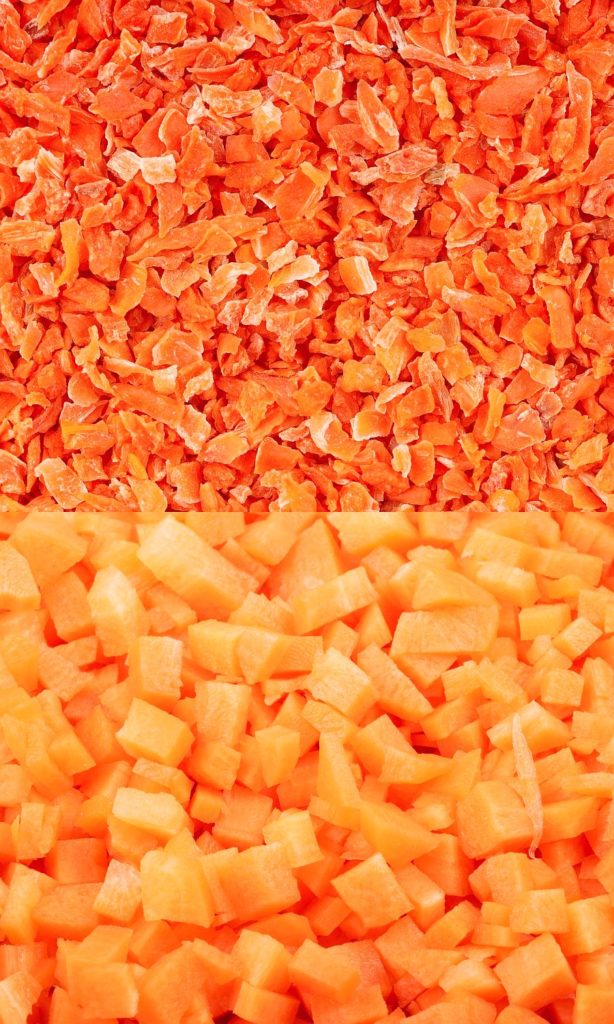Many people occasionally feed their dogs carrots as a refreshing healthy treat. This orange root vegetable is a popular low-calorie snack and most dogs love carrots.
But why are carrots used as a dog food ingredient?
Contents
About Carrots In Dog Food
Carrots (Daucus carota) are relatively short-lived herbs that are harvested for their fleshy taproot. Although there are yellow, red, or purple varieties most carrots are orange.
Carrot production can be wasteful since this vegetable is rather fragile and cannot be stored for too long. Dog food manufacturers likely use surplus or discarded carrots from overproduction.

Surprisingly, carrots can be found in almost half of all dog food recipes, especially in wet dog food products.
For dog food products […] flaxseed, peas and carrots are the top three most commonly used plant ingredients
Pet Food Production and Ingredient Analysis 2020[1]
Benefits Of Carrots In Dog Food
Carrots can serve several purposes in dog food formulas.
Their main benefits seem to be that are cheap and readily available and provide beta-carotene (provitamin A), sugar, color, flavor, and some fiber.
Fresh carrots are very high in moisture (+-90%) and contain vitamins like vitamin C, vitamin K, or vitamin B6, minerals, and some phytochemicals like terpenes or carotenoids.
| Nutrient content per 100 g[2] | |
|---|---|
| Water | 88 g |
| Protein | 1 g |
| Fat | 0.35 g |
| Carbs | 10 g |
| Fiber | 3 g |
| Energy | 48 kcal |
| MINERALS | |
| Potassium | 280 mg |
| Sodium | 87 mg |
| Magnesium | 12 mg |
| Calcium | 30 mg |
| Phosphorus | 40 mg |
| Zinc | 0.24 mg |
| Iron | 0.15 mg |
| Manganese | 0.13 mg |
| Selenium | <2.5 µg |
| VITAMINS | |
| Vitamin C | 5.9 mg |
| Vitamin E | 0.66 mg |
| ß-carotene | 8285 μg |
| Lutein/Zeaxanthin | 256 μg |
| Thiamine | 0.066 mg |
| Riboflavin | 0.095 mg |
| Niacin | 1.41 mg |
| Biotin | 2.22 µg |
| Folate | 37 µg |
| Pantothenic Acid | 0.273 mg |
| Vitamin B6 | 0.146 mg |
| Vitamin K | 13.2 μg |
Carrots get their bright color from their main nutrient, a carotenoid called ß-carotene.
This red-orange pigment is responsible for the carrot’s characteristic orange color and is also a precursor of vitamin A.
Their water content often lands fresh carrots a place in the first half of the ingredient list when used in dog food formulas.
But remember, during dog food processing, carrots are cooked and will likely lose some of their nutrient content.

The dry matter of carrots is mostly made up of highly digestible sugars giving them their typical sweet taste and making dried carrots a flavorful high-energy food.
Although carrots do not contain significant amounts of protein and fat, like many vegetables they obviously do provide some fiber.
How Are Carrots Used In Dog Food?
Most recipes seem to use fresh carrots and carrot pieces. Some premium recipes even use organic carrots.
In some dried or precooked products, visible small pieces of carrot are used to offer variety and some color accents.

There are various by-products of carrot processing like carrot juice or carrot pomace which are rarely found in pet foods.
But due to their ß-carotene and sugar content, carrots are often used as a natural source of pigments and to provide some natural flavor.
Aside from whole carrots, some manufacturers may use processed carrot ingredients like extracts, powders, or oils.
- Carrot extracts can make dog food more palatable.
- Carrot powder from dried ground carrots can be used as a natural food coloring.
- Carrot oil is a color additive that contains chemically extracted fats, waxes, and carotenes naturally occurring in carrots.
Further Reading
[1] Pet Food Production and Ingredient Analysis (PDF). 2020. Institute for Feed Education and Research (IFEEDER), North American Renderers Association (NARA), Pet Food Institute (PFI)
[2] U.S. Department of Agriculture. Agricultural Research Service. FoodData Central. 2019. fdc.nal.usda.gov
